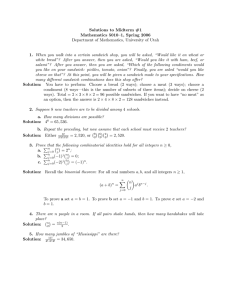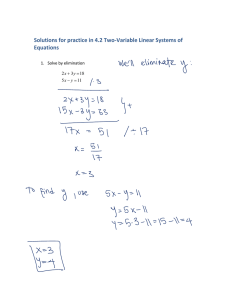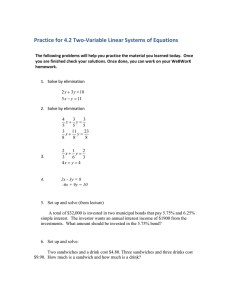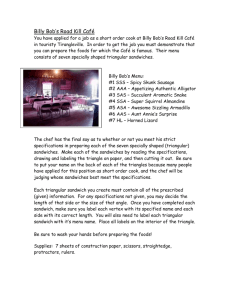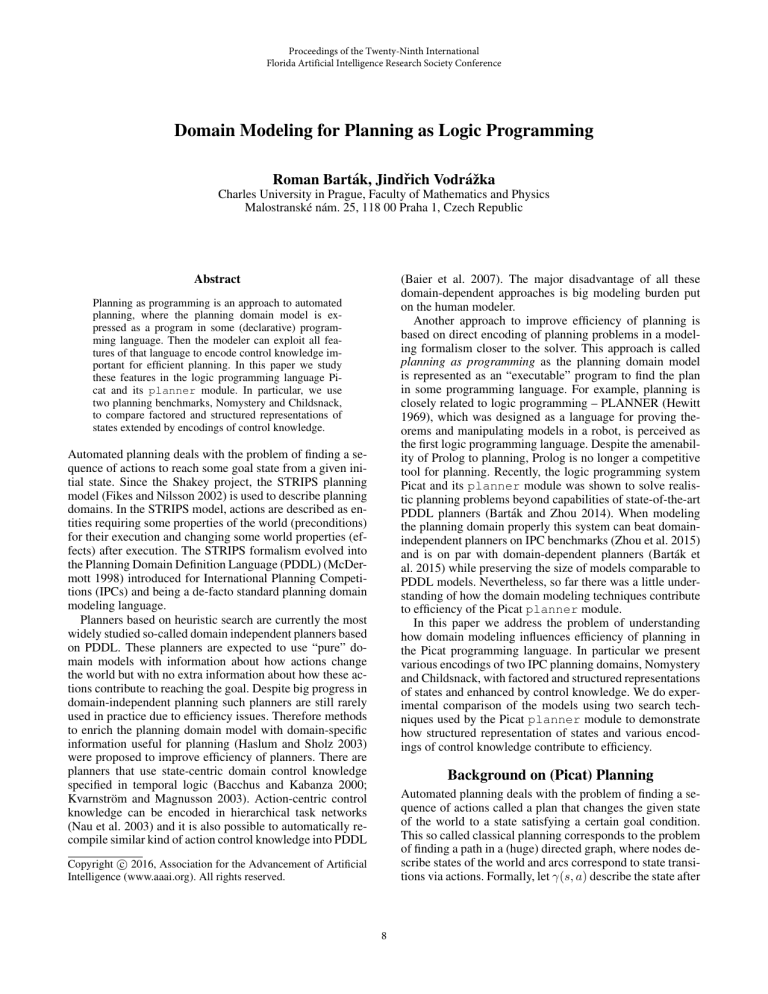
Proceedings of the Twenty-Ninth International
Florida Artificial Intelligence Research Society Conference
Domain Modeling for Planning as Logic Programming
Roman Barták, Jindřich Vodrážka
Charles University in Prague, Faculty of Mathematics and Physics
Malostranské nám. 25, 118 00 Praha 1, Czech Republic
(Baier et al. 2007). The major disadvantage of all these
domain-dependent approaches is big modeling burden put
on the human modeler.
Another approach to improve efficiency of planning is
based on direct encoding of planning problems in a modeling formalism closer to the solver. This approach is called
planning as programming as the planning domain model
is represented as an “executable” program to find the plan
in some programming language. For example, planning is
closely related to logic programming – PLANNER (Hewitt
1969), which was designed as a language for proving theorems and manipulating models in a robot, is perceived as
the first logic programming language. Despite the amenability of Prolog to planning, Prolog is no longer a competitive
tool for planning. Recently, the logic programming system
Picat and its planner module was shown to solve realistic planning problems beyond capabilities of state-of-the-art
PDDL planners (Barták and Zhou 2014). When modeling
the planning domain properly this system can beat domainindependent planners on IPC benchmarks (Zhou et al. 2015)
and is on par with domain-dependent planners (Barták et
al. 2015) while preserving the size of models comparable to
PDDL models. Nevertheless, so far there was a little understanding of how the domain modeling techniques contribute
to efficiency of the Picat planner module.
In this paper we address the problem of understanding
how domain modeling influences efficiency of planning in
the Picat programming language. In particular we present
various encodings of two IPC planning domains, Nomystery
and Childsnack, with factored and structured representations
of states and enhanced by control knowledge. We do experimental comparison of the models using two search techniques used by the Picat planner module to demonstrate
how structured representation of states and various encodings of control knowledge contribute to efficiency.
Abstract
Planning as programming is an approach to automated
planning, where the planning domain model is expressed as a program in some (declarative) programming language. Then the modeler can exploit all features of that language to encode control knowledge important for efficient planning. In this paper we study
these features in the logic programming language Picat and its planner module. In particular, we use
two planning benchmarks, Nomystery and Childsnack,
to compare factored and structured representations of
states extended by encodings of control knowledge.
Automated planning deals with the problem of finding a sequence of actions to reach some goal state from a given initial state. Since the Shakey project, the STRIPS planning
model (Fikes and Nilsson 2002) is used to describe planning
domains. In the STRIPS model, actions are described as entities requiring some properties of the world (preconditions)
for their execution and changing some world properties (effects) after execution. The STRIPS formalism evolved into
the Planning Domain Definition Language (PDDL) (McDermott 1998) introduced for International Planning Competitions (IPCs) and being a de-facto standard planning domain
modeling language.
Planners based on heuristic search are currently the most
widely studied so-called domain independent planners based
on PDDL. These planners are expected to use “pure” domain models with information about how actions change
the world but with no extra information about how these actions contribute to reaching the goal. Despite big progress in
domain-independent planning such planners are still rarely
used in practice due to efficiency issues. Therefore methods
to enrich the planning domain model with domain-specific
information useful for planning (Haslum and Sholz 2003)
were proposed to improve efficiency of planners. There are
planners that use state-centric domain control knowledge
specified in temporal logic (Bacchus and Kabanza 2000;
Kvarnström and Magnusson 2003). Action-centric control
knowledge can be encoded in hierarchical task networks
(Nau et al. 2003) and it is also possible to automatically recompile similar kind of action control knowledge into PDDL
Background on (Picat) Planning
Automated planning deals with the problem of finding a sequence of actions called a plan that changes the given state
of the world to a state satisfying a certain goal condition.
This so called classical planning corresponds to the problem
of finding a path in a (huge) directed graph, where nodes describe states of the world and arcs correspond to state transitions via actions. Formally, let γ(s, a) describe the state after
c 2016, Association for the Advancement of Artificial
Copyright Intelligence (www.aaai.org). All rights reserved.
8
applying action a to state s, if a is applicable to s (otherwise
the function is undefined). Then the planning task is to find a
sequence of actions a1 , a2 , . . . , an called a plan such that,
s0 is the initial state, for each i ∈ {1, . . . , n}, ai is applicable to state si−1 , si = γ(si−1 , ai ), and sn is a goal state.
For solving cost-optimization problems, a non-negative cost
is assigned to each action and the task is to find a plan with
the smallest cost. The major difference from classical pathfinding is that the state space for planning problems is enormous and does not fit in memory. Hence a compact representation of states and actions (and state transitions) is necessary. This representation is called a domain model.
Since the time of Shakey The Robot the factored representation of states is used, which has been reflected later
in the design of the Planning Domain Definition Language
(PDDL) (McDermott 1998). In this representation a state
consists of a vector of attribute values and actions are changing values of certain variables (action effect) while requiring values of some attribute variables as preconditions. In
a structured representation a state model describes objects
possibly with attributes as well as relations between the objects. Action models based on first-order logic are close to
this representation, but we are not aware of any widelyused planning domain modeling language based on structured representation that leads to efficient planners. The Picat planner module supports both factored and structured
representations of states – the state is represented by any
term.
The detailed description of Picat domain models can be
found in (Barták et al. 2015). Briefly speaking the planning
domain model in Picat is expressed as a set of action rules
describing the transition function γ in the form:
mal plans. Both of them are based on depth-first search with
tabling and they correspond to classical forward planning by
starting in the initial state and finding an action applicable to
the state etc. until a plan is found (alternatives are explored
upon backtracking).
The first approach starts with finding any plan using the
depth-first search. The initial limit for plan cost can (optionally) be imposed. Then the planner tries to find a plan with
smaller cost so a stricter cost limit is imposed. This process
is repeated until no plan is found so the last plan found is
an optimal plan. This approach is very close to branch-andbound technique (Land and Doig 1960). Note that tabling is
used there – the underlying solver remembers the best plans
found for all visited states (with a given cost limit) so when
visiting the state next time, the plan is retrieved rather than
looked for again.
The second approach exploits the idea of iteratively increasing the cost limit and looking for a plan with a given
cost limit. The approach first tries to find a plan with cost
zero. If no plan is found, then it increases the cost by 1. In
this way, the first plan that is found is guaranteed to be optimal. Unlike the IDA* search algorithm (Korf 1985), which
starts a new round from scratch, Picat reuses the states that
were tabled in previous rounds.
Picat uses linear tabling to memorize answers to calls
which implicitly prevents loops and brings properties of
graph search (not exploring the same state more than once)
to classical depth-first search used by Prolog-like languages.
Tabling can also be used to remember “best” answers so
it can be exploited to find optimal plans. Picat supports
so called resource-bounded search that prevents exploring
paths exceeding a given cost limit (Zhou et al. 2015).
action(+State,-NextState,-Action,-Cost),
precondition,
[control_knowledge]
?=>
description_of_next_state,
action_cost_calculation.
Domain Models
To demonstrate capabilities of the Picat planner module we
have selected one traditional planning benchmark domain
– Nomystery from IPC 2011 – and one recent domain –
Childsnack from IPC 2014. The major criterion for selection was existence of natural control knowledge – in other
words there is some “common sense” guidelines that humans would use to solve problems in these domains. We also
looked for domains with a small number of operators as we
needed to manually design several domain models.
In this section, we will explain factored and structured
representations for each domain and we will describe encoding of control knowledge for these domains. The factored
representations basically mimic the original PDDL encodings of the domains. The structured representations as well
as control knowledge are tailored for each domain separately
though the reader can observe some unifying principles.
One of the motivations for this research is showing how
efficient domain models look like. Though we use Picat for
domain modeling, we believe that similar knowledge (till
some extent) can be encoded in PDDL. As PDDL uses a
factored representation of states and actions with preconditions and effects only, we encoded the control knowledge for
the factored representation also in the PDDL style.
This rule gets some State as its input and should produce NextState as its output together with some description of Action used for the transition and non-negative
Cost of that action. If the plan’s length is the only interest, then this cost equals one. The above pseudo-code gives
the typical action rule, where precondition is evaluated
first together with optional control knowledge telling
when the rule can be applied. These are arbitrary Picat calls.
Then the effect of the action is described when building the
NextState together with setting the action Cost.
Note, that in the above pseudo-code we used a nondeterministic version of the state-transition rule (?=>). Like
in Prolog, the domain model consists of a set of rules that
are tried in the top-down order (hence the order of rules
matters). It means that during backtracking the next applicable rule (action) is explored provided that it is backtrackable. The domain modeler can specify that a given action
rule should be applied to a given state and if its application does not lead to a (best) plan then the next action rules
are not tried. This is done by using deterministic rules (=>).
The Picat planner uses two search approaches to find opti-
9
Nomystery
action({Loc,Fuel,LCGs,WCGs},NextState,
Action,ActionCost),
select([Loc|CargoGoal],WCGs,WCGs1)
?=>
Action = $load(Loc,CargoGoal),
ActionCost = 1,
NextState = {Loc,Fuel,LCGs1,WCGs1},
LCGs1 = insert_ordered(LCGs,CargoGoal).
In the Nomystery domain, there is a single truck with unlimited load capacity, but with a given (limited) quantity of
fuel. The truck moves in a weighted graph where a set of
packages must be transported between nodes. Actions move
the truck along edges and load/unload packages. Each move
consumes the edge weight in fuel so the initial fuel quantity
limits how far the truck can move (no refueling is assumed).
The factored representation uses predicates at/2 to define locations of the truck and of cargo items, and predicates in/2 telling that a cargo item is loaded in the truck.
There is also a single predicate fuel/2 describing a fuel
level of the truck. In Picat we encode these predicates as ordered lists containing the predicate arguments (ordered lists
represent sets in a unique way). Together, we represent the
state using a triple {Fuel,AtPreds,InPreds}, where
Fuel is the current fuel level of the truck. Recall that there
is a single truck so in each state there is a single predicate
fuel(Truck,Fuel). This is how the action load looks
like in the Picat domain model with the factored representation of states (cargo C is loaded to truck T at location L):
The control knowledge is expressed via ordering of action rules and using deterministic rules and via extra conditions for action applicability. The control knowledge for the
Nomystery domain exploits information that there is no capacity restriction of the single truck. First, when the cargo
item is delivered, it can be removed from the state representation because there will be no other actions related to this
item (any action that manipulates an already delivered item
only enlarges the plan). Second, the truck should load all
cargo items at its current location before driving somewhere
else. If any item is left there then the truck needs to return
to that location to load that item later, which only enlarges
the plan (recall, that there is a single truck in the domain).
This can be achieved by putting the load action before the
driving action and setting the action rule for loading to be
deterministic (if anything can be loaded then the load action
is used first). Finally, any loaded cargo is kept loaded until
the truck reaches cargo’s destination. This is achieved by unloading the cargo item only at its destination. We can make
this rule even stronger – the truck does not leave a given location until all loaded cargo items destined to this location
are unloaded. Together, we put the unload action before the
drive action, we add extra condition that an item is unloaded
only at its destination, and we make the action rule for unloading deterministic so all cargo items (for current location)
are unloaded before trying another action. The only remaining non-determinism to be explored by search is where the
truck should go.
If we want to keep the PDDL structure of actions with the
factored representation and without deterministic rules then
we can do it by strengthening action preconditions by using
information about the goal. We can store this information in
the Picat database (similarly to object types) and then actions
can exploit it. This is how the action load looks like with
encoded control knowledge in the PDDL style:
action({Fuel,AtPred,InPred},NextState,
Action,ActionCost),
truck(T),
member([T|L],AtPred),
select([C|L],AtPred,RestAtPred), C!=T
?=>
Action = $load(C,T,L),
ActionCost = 1,
NextState = {Fuel,RestAtPred,NewInPred},
NewInPred = insert_ordered(InPred,[C|T]).
The above rule can be obtained automatically from the
PDDL model. The predicate truck(T) is stored in the
Picat database and represents the type of object in PDDL.
Checking validity of action preconditions is realized via set
operations member and select depending on whether the
validity of the predicate will be changed (select) or not
(member). Action effects are modeled by adding the new
valid predicates to the state via insert ordered.
The structured representation focuses on removing object symmetries by representing objects via their (possibly changing) attributes rather than via their names. For
example, we can represent each cargo item as a pair
[CurrLoc|GoalLoc] describing the current location
and goal location of the item. The current state is then represented using the tuple {Loc,Fuel,LCGs,WCGs}, where
Loc is the location of the truck, Fuel is the truck’s fuel
level, LCGs is an ordered list of destinations of loaded
cargo items, and WCGs is an ordered list of waiting cargo
items, each item is represented as we described above. Similar symmetry breaking properties can be achieved in PDDL
by using “resource predicates”. For example, the predicate
at(Loc,Dest,Q) may describe how many packages are
waiting at a given location for being delivered to a given
destination.
This is how the action load looks like when using the
structured state representation. Notice that the cargo item
is identified in the action by its destination so some postprocessing is necessary to put object names back to the plan.
action({Fuel,AtPred,InPred},NextState,
Action,ActionCost),
truck(T), goal(G),
member([T|L],AtPred),
not (member([C1|T],InPred),
member([C1|L],G)), % nothing to unload
select([C|L],AtPred,RestAtPred), C!=T,
not member([C|L],G)
?=>
Action = $load(C,T,L),
ActionCost = 1,
NextState = {Fuel,RestAtPred,NewInPred},
NewInPred = insert_ordered(InPred,[C|T]).
The action says that loading is possible only if there is nothing to unload (no loaded cargo item destined for the current
location) and if the cargo item to be loaded belongs to a different location. Note that the model of actions is now depen-
10
dent on the type of goal and when a different type of goal is
used (for example the goal is to move the truck somewhere)
then the model of actions would be different.
To demonstrate that the Picat model of actions is close to
the PDDL model, this is how the action load looks like in
the original PDDL model:
?=>
Action = $put_on_tray(Sw,Tr),
NextState={Bread,Content,RSandwiches,
NewOnTray,SwNoGluten,SwNames,
Trays,Childs},
NewOnTray=insert_ordered(OnTray,{Sw,Tr}),
ActionCost = 1.
(:action LOAD
:parameters
(?p - package
?t - truck
?l - location)
:precondition
(and (at ?t ?l) (at ?p ?l))
:effect
(and (not (at ?p ?l)) (in ?p ?t)
(increase (total-cost) 1))
)
The structured representation removes object symmetries
by ignoring names of bread, content, and sandwiches, and
representing each of them using either constant no gluten
or constant gluten. The not-yet made sandwich is represented by constant free. For children we can also ignore the names so we can represent each children using a
pair {Loc,Type}, describing location and “type” of children (gluten or no gluten). Also the trays are represented by their location and loaded sandwiches as a pair
{Loc,Load}, where Loc is the current location of the tray
and Load is an ordered list of sandwiches loaded to that tray
(recall that sandwich is only identified by its type). So the
path of the sandwich starts as free. When the sandwich is
made, its identification changes to no gluten or gluten.
If the sandwich is put on tray, it is placed to the corresponding Load list, and finally, if the sandwich is served
then it disappears from the state. In summary, the structured state is represented by a tuple {Bread, Content,
Sandwiches, Trays, Childs}, where the first three
components are ordered lists of object types, Trays is an
ordered list of pairs {Location,Load}, and Childs is
an ordered list of pairs {Loc,Type}. This is how the action
put on tray looks like:
Childsnack
The task in the Childsnack domain is to plan how to make
and serve sandwiches for a group of children in which some
are allergic to gluten. There are two actions for making sandwiches from various ingredients. The first one makes a sandwich and the second one makes a sandwich taking into account that all ingredients are gluten-free. There are also actions to put a sandwich on a tray, to move the tray between
locations, and to serve sandwiches. Problems in this domain
define the ingredients to make sandwiches at the initial state.
Goals consist of having all kids served with a sandwich to
which they are not allergic.
The factored representation again mimics the
original PDDL encoding that uses predicates
to identify bread at kitchen bread/1, conand
sandwiches
tent
at kitchen content/1,
at kitchen sandwich/1 in kitchen, sandwiches
placed on trays on tray/2, locations of trays at/2, and
kids that have been served served/1. There are some rigid
predicates defining that the content and bread is gluten-free,
while this information must be kept as a fluent for sandwiches (no gluten sandwich/1). Notice that names
of sandwiches are used to identify sandwiches so predicates
notexist/1 are used to indicate that there is a prospective
sandwich. Hence the “life” of sandwich starts as notexist
which then changes to at kitchen sandwich possibly
accompanied by no gluten sandwich, followed by
on tray, and finally disappearing after being served
to a child. In summary, the state is represented as tuple {Bread, Content, Sandwiches, OnTray,
SwNoGluten, SwNames, TrayLocs, Childs},
where each component is an ordered list of names (constants) or pairs of names (for OnTray and TrayLocs).
We used a complementary representation of predicate
served/1 so the list Childs represents not-yet served
children. This is how the action put on tray looks like:
action({Bread,Content,Sandws,Trays,Childs},
NextState,Action,ActionCost),
select(Type,Sandws,RSandws),
Type!=free,
select([kitchen|Load],Trays,RTrays)
?=>
Action = $put_on_tray(Type),
NextState = {Bread,Content,RSandws,
NewTrays,Childs},
NewTrays = insert_ordered(RTrays,
[kitchen|insert_ordered(Load,Type)]),
ActionCost = 1.
There is a deterministic method to find an optimal plan.
First, for each children we need to make a sandwich. Glutenfree sandwiches are made first to ensure that there is enough
gluten-free bread and content. Note that this requires to
modify the representation of children as we need to distinguish between children with sandwich ready for them and
children with no sandwich made for them yet. The factored
representation can be extended by a new predicate for this
property; the structured representation can add one argument
to the model. Only when all sandwiches are made, they are
all placed to a single tray (that may need to be moved to
kitchen first). As no parallel plans are assumed, using more
trays will not shorten the plan and hence a single tray is
enough. That tray is then moved between locations and all
children in each location are served before moving to another location. We used non-deterministic selection of the
next location to visit to include some search decisions on
the model.
action({Bread,Content,Sandwiches,OnTray,
SwNoGluten,SwNames,Trays,Childs},
NextState,Action,ActionCost),
member({Tr,kitchen},Trays),
select(Sw,Sandwiches,RSandwiches)
11
Table 1: The number of problem instances.
The factored representation with control knowledge for
put on tray in Picat is identical to the above presented rule
– only the rule is made deterministic (=>) and placed after
the action rules for make sandwich and before the action
rule for move tray to ensure that loading is done after all
sandwiches are made and before the tray leaves kitchen. Using the determinism also implicitly removes symmetries between sandwiches as they are loaded in a fixed order. If deterministic rules cannot be exploited then we need to break
all these symmetries explicitly by assuming some order of
objects (@<) as the following code shows:
domain
Nomystery
Childsnack
#instances
30
20
#optimal
30
20
#state-of-the-art
“20” (FFSS1)
10 (dynamic-gamer)
planner uses either branch-and-bound or iterative deepening
form of search so we will present the results separately for
these two search approaches.
Figure 1 shows how the number of problems solved optimally depends on time for the Nomystery domain; Figure 2
shows the same for the Childsnack domain (no problem was
solved using the pure factored representation and the difference between the models with control knowledge are indistinguishable). The results are as expected – adding control
knowledge helps significantly. The experiment also confirms
that exploiting stronger modeling techniques such as structured representation of states, ordering of actions, and deterministic actions is beneficial. If we encode the same control knowledge in the PDDL style (via action preconditions),
then the extra overhead decreases efficiency of planning.
action({Bread,Content,Sandwiches,OnTray,
SwNoGlut,SwNames,Trays,Childs,Ready},
NextState,Action,ActionCost),
Childs = [],
member({Tr,kitchen},Trays),
not (member({Tr1,kitchen},Trays),Tr1@<Tr),
select(Sw,Sandwiches,RSandwiches),
not (member(Sw1,RSandwiches), Sw1@<Sw)
?=>
Action = $put_on_tray(Sw,Tr),
NextState={Bread,Content,RSandwiches,
NewOnTray,SwNoGlut,SwNames,
Trays,Childs,Ready},
NewOnTray=insert_ordered(OnTray,{Sw,Tr}),
ActionCost = 1.
The rule checks that sandwiches for all children are made
(Childs=[]) and then it selects the first tray in the kitchen
and the first sandwich to be loaded (the conditions say that
no tray/sandwich with smaller id satisfies the conditions).
Experimental Evaluation
To show how presented modeling techniques influence efficiency of planning, we experimentally compared them using
the existing problems from IPC. For each problem, we limited runtime to 30 minutes (if exceeded then the problem is
treated as unsolved) and memory to 1GB. The experiments
R CoreTM i7run on a computer with Picat 1.4 and Intel
960 running at 3.20GHz with 24 GB (1066 MHz). Table 1
shows the number of problem instances per domain and the
number of instances solved optimally by our best model with
structured representation and control knowledge. To demonstrate efficiency of Picat models in comparison with stateof-the-art planners we also include the number of problem
instances solved optimally by best performing planner participating at the respective IPC. For the Nomystery domain it
was Fast Downward Stone Soup 1 (but note that there were
only 20 problem instances included for the Nomystery domain at IPC 2011 whereas our set of benchmarks contains 10
more instances). For the Childsnack domain the best planner (for this domain) was dynamic-gamer. Both PDDL planners run on a comparable computer (FSS1 on Intel Xeon
2.93 GHz with 6 GB and dynamic-gamer on AMD Processor 2.39 Ghz with 4 GB) with 30 minutes runtime limit.
We will present now the comparison of the following
Picat models: pure factored representation, factored representation with control knowledge, structured representation
with control knowledge, and factored representation with
control knowledge in the PDDL style. Recall that the Picat
Figure 1: The number of problems solved within a given
time for iterative deepening (top) and branch-and-bound
(bottom) for the Nomystery domain.
Conclusions
Research in automated planning is dominated by interest
in domain-independent planning techniques. Despite a big
progress in recent years, these techniques are still far from
being applicable to practical problems in areas such as computer games and robotics. Planning via programming might
12
symmetries (Riddle et al. 2015) and by discovering useful
control knowledge.
Acknowledgements. Research is supported by the Czech
Science Foundation under the project P103-15-19877S.
References
Bacchus F. and Kabanza F. 2000. Using temporal logics to
express search control knowledge for planning. Artificial Intelligence, 116(1-2):123–191.
Baier J.; Fritz C.; and McIlraith S. A. 2007. Exploiting procedural domain control knowledge in state-of-the-art planners. In Proceedings of the 17th International Conference
on Automated Planning and Scheduling – ICAPS, 26–33.
Barták R. and Zhou N-F. 2014. Using tabled logic programming to solve the Petrobras planning problem. Theory and
Practice of Logic Programming, 14(4-5):697–710.
Barták R.; Dovier A.; and Zhou N-F. 2015. On modeling
planning problems in tabled logic programming. In Proceedings of the 17th International Symposium on Principles and
Practice of Declarative Programming – PPDP’15, 32–42.
Chrpa, L.; Barták R. 2016. Guiding Planning Engines by
Transition-based Domain Control Knowledge. In Proceedings of the 15th International Conference on Principles of
Knowledge Representation and Reasoning – KR 2016.
Fikes R. E. and Nilsson N. J. 1971. STRIPS: A New Approach to the Application of Theorem Proving to Problem
Solving. Artificial Intelligence, 2 (3-4): 189–208.
Haslum O. and Scholz U. 2003. Domain knowledge in
planning: Representation and use. In ICAPS Workshop on
PDDL.
Hewitt C. 1969. Planner: A language for proving theorems
in robots. In Proceedings of IJCAI, 295–302.
Korf R. E. 1985. Depth-first iterative-deepening: An optimal
admissible tree search. Artificial Intelligence, 27(1), 97–109.
Kvarnström J. and Magnusson M. 2003. Talplanner in the
third international planning competition: Extensions and
control rules. J. Artificial Intelligence Research (JAIR),
20:343–377.
Land A. H. and Doig A. G. 1960. An automatic method
of solving discrete programming problems. Econometrica
28(3): 497–520.
McDermott D. 1998. The planning domain definition language manual. CVC Report 98-003, Yale Computer Science
Report 1165.
Nau D.S.; Au T-Ch.; Ilghami O.; Kuter U.; Murdock J.W.;
Wu D.; and Yaman F. 2003. SHOP2: an HTN planning system. J. Artificial Intelligence Research (JAIR), 20:379–404.
Riddle P.; Barley M.; and Franco S. 2015. Automated Transformation of Problem Representations. In Proceedings of
The 8th Annual Symposium on Combinatorial Search.
Zhou N-F.; Barták R.; and Dovier A. 2015. Planning as
Tabled Logic Programming. Theory and Practice of Logic
Programming, 16(4-5): 543–558.
Figure 2: The number of problems solved within a given
time for iterative deepening (top) and branch-and-bound
(bottom) for the Childsnack domain.
be an approach to give practical efficiency for solving reallife problems without adding extra burden to planning domain modeling. In comparison to HTN the modeler is not
required to provide a global structure of the plan and can
express just local conditions for action applicability (see the
Nomystery domain) though it is also possible to specify plan
structure via suggested action sequences (see the Childsnack
domain). The Picat models are also much smaller than models with control rules (Barták et al. 2015).
In this paper, we sketched the major ideas behind modeling planning domains in Picat. We gave examples of factored representation that can be obtained by direct translation of PDDL domains. We also presented structured representation that is more compact and can remove symmetries
by representing objects via their properties rather than via
their names. Both representations can be extended by control knowledge whose encoding exploits properties of Picat
programming, namely using the order of action rules and
deterministic selection of rules. We also showed that control knowledge can be encoded in the PDDL style though
the performance is not as good as direct encoding. The initial experiments with encoding domain control knowledge
in PDDL showed similar behavior – improvement of performance but not as significant as with the Picat models (Chrpa
and Barták 2016). The models are not much larger than original PDDL models while achieving better efficiency by exploiting action-oriented control knowledge and object symmetry breaking. The major open question is how to automatically enhance the model for example by removing object
13

